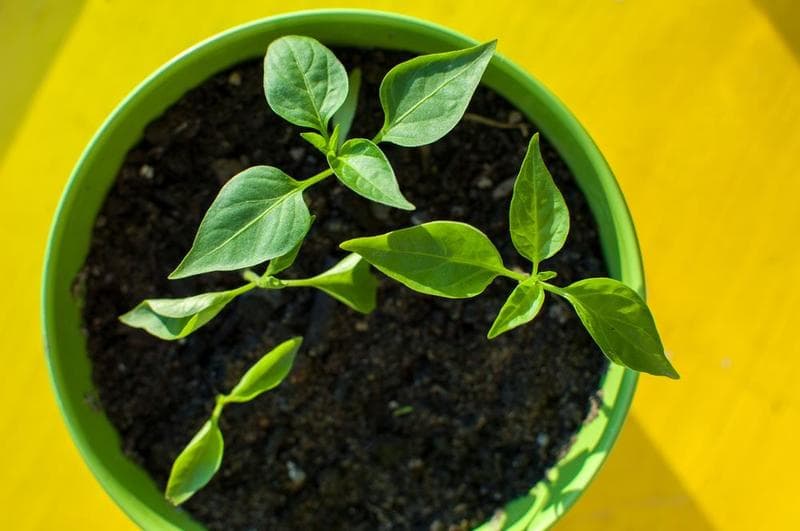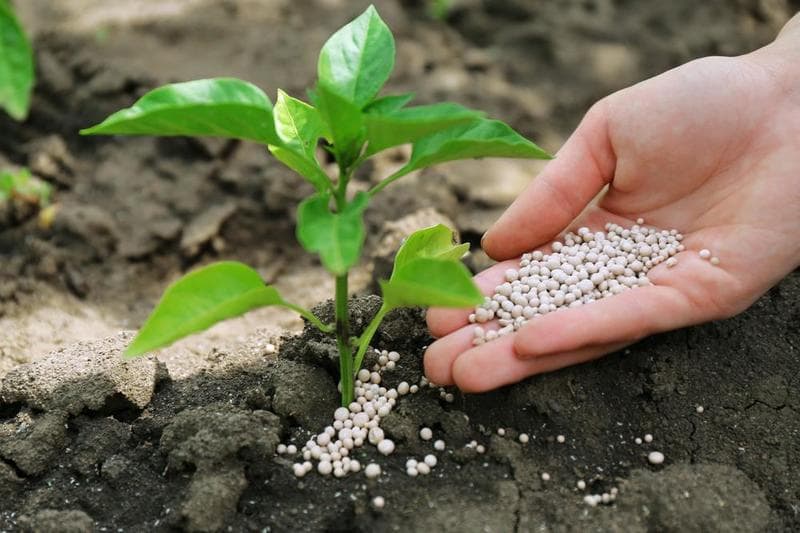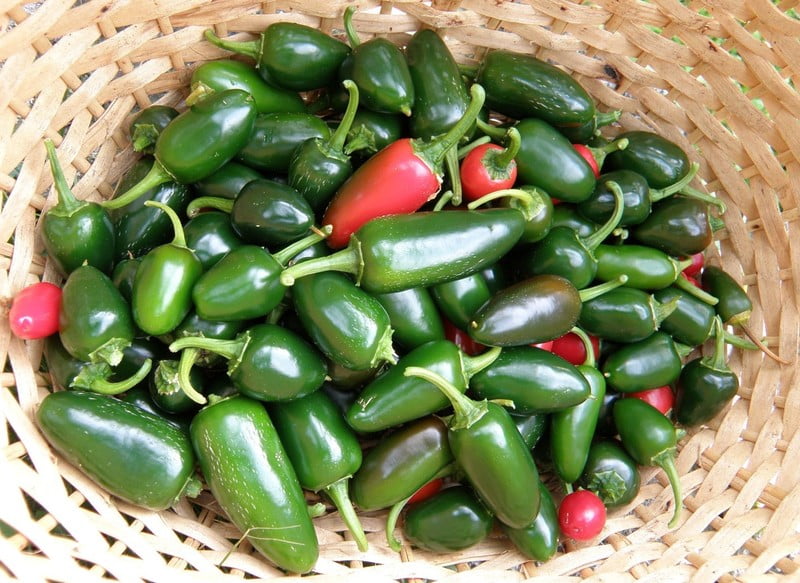Jalapeno peppers are undoubtedly the most popular type of chili pepper in the world. The name refers to the area where the peppers were originally grown: Xalapa, in Mexico. Nowadays, jalapeno peppers have spread worldwide due to their popularity in most dishes, from South America to Asia. Regarding spiciness, jalapeno peppers are not as hot as other varieties; therefore, they are quite palatable for most people. In terms of nutritional facts, jalapeno peppers are rich in vitamin C, A, potassium, and especially capsaicin which creates their spiciness or heat. Eating jalapenos is beneficial for those who wish to lose some weight as the heat factor helps to burn calories or fat. Capsaicin helps to kill cancer cells, acts as anti-inflammatory agent to help deal with arthritis, eases pain such as headaches, and reduces the risk of heart attack and high blood pressure. You may wish to have some jalapeno plants with their delicious fruits close to hand to add to your daily healthy diet. This is certainly possible as long as you master the simple tips for growing jalapeno peppers below.
Growing Jalapenos with 8 Simple Steps
1. Growing Time
Jalapeno peppers thrive in warm rather than cool or cold weather. The optimal temperature for growing jalapenos is around 65°F at night and 75°F to 85°F during the daytime. This is a prerequisite for the seeds to sprout. However, when the temperature reaches higher than 90°F, or 32°C, your pepper plants will probably not be fruitful. So, if you plan to grow jalapenos at home, wait until the outdoor temperature is in the range of 65°F to 85°F, or adjust the indoor environment to the optimal conditions for indoor growing.
2. Growing Space

Peppers are best grown in a small vegetable garden. However, it is also possible to grow them in containers. You can utilize roof, floor, balcony, or window space to place the pots. Jalapenos do not require a lot of space, but the containers should be around 2 to 5 gallons in volume for the plants to bear fruit. The base of the containers should be poked with holes to allow for good water drainage. You’ll need to prepare one container for each pepper plant that you wish to grow. Purchasing different pot sizes is advisable as the plants will be transplanted from a small, to a medium to a large container to allow for their full growth potential.
3. Soil
Jalapeno peppers grow well in loamy, well-drained soil. You’ll need to remove any sticks, rocks or debris from the soil, and mix it with compost or well-rotted manure in order to provide sufficient nutrients for the plants. Purchased potting soil for container growing has already been made with a balanced mixture of compost and other ingredients, so it should be ready for use. In case the soil dries out too quickly, a plastic wrap over the containers may help to retain moisture in the soil, otherwise mulching will help retain moisture.
4. Seeds and Seedlings

You can grow jalapenos from either seeds or seedlings bought from your local garden center. For purchased seedlings, you can simply transplant them into your dedicated growing space and care for the plants till harvest time. If you grow them from seeds, sow each container with 2-3 seeds, cover with ¼ inch of soil, moisten well, and place in a warm area. A seeding tray may work well for the seeding stage as each seed then has its own space. As long as you provide optimal conditions of soil, moisture and temperature, young jalapeno plants will begin to grow after two weeks. When the seedlings are 2 inches tall with 4 leaves, they are ready for transplanting into larger containers. If you transplant from indoors to outdoors, hardening the young pepper plants off before transplanting them out can help the plants to prepare for their new tough outdoor environment.
5. Seedling Care
Transplanted jalapeno seedlings need as many hours of direct sunlight per day as possible. Thus, make sure you plant them in a well-lit area. If it is impossible for direct sunlight to reach your indoor planting rooms, you will need to hang artificial lights over the plants from 2 to 4 inches above them to provide sufficient light for their healthy growth.
Water is also as important as light, because moist growing conditions of jalapeno peppers should be well maintained. If you plant indoors, watering twice a week is sufficient. Outdoor planting may require more frequent watering, but the overall parameter is an inch of water per week. If possible, use a moisture meter to determine exactly when you need to water the plants. Drip irrigation could also be considered as it helps to save both water and effort while achieving optimal moisture conditions.
6. Fertilizers

Start growing jalapeno peppers with initially fertile soil should condition the proper growth of your jalapeno peppers for the first month after being planted outdoors. In order to boost growth and ensure a fruitful harvest, 10-10-10 NPK fertilizers should be used after this stage. Read the instructions carefully to determine the dose and frequency of fertilizing. Well-rotted manure and compost are ideal for fertilizing as well. Those are organic fertilizers which slowly release nutrients into the soil in the longer term. Remember to water after fertilizing so that the chemicals become evenly distributed to the root base.
7. Pest/Disease Control
As long as the soil is weed free, and proper spacing between plants and rows is maintained, jalapeno peppers are almost maintenance free, with few pests and diseases. However, the peppers do sometimes come under attack by cutworms, aphids, and flea beetles. Handpicking those pests is advisable, but in cases of heavy infestation, organic pesticides can be used to control them. This is a simple matter if you are just growing a few jalapeno peppers, but it is more of an effort if you own a large square of jalapenos. As mentioned earlier, cleaning the soil, removing weeds and maintaining appropriate moisture levels will help to minimize pests and diseases.
8. Harvesting

From seeds to peppers, it takes between 90 to 120 days for the 3-to-4-foot-tall mature plants to produce their very first fruits. You may choose to harvest when they are still green, or wait till they are red and ripe. Depending on the variety, jalapeno peppers may grow between 2 to 3 inches long. Picking the first fruits will urge a more abundant harvest to form later. After all your hard work, enjoy harvesting your crop and tasting the mild spicy green or red pepper in various dishes.
Conclusion
In short, it’s just a matter of a little time and patience to grow, care for and harvest jalapeno peppers. From sowing, transplanting, watering, fertilizing and harvesting, each stage requires you to put a little effort into it, but the final results really pay you back handsomely. Not only can you add fresh, spicy taste into every dish, but also the potted jalapenos plants make an attractive decoration around your home. Start growing jalapenos now to enjoy fruitful pickings later!
Last Updated on



Reply